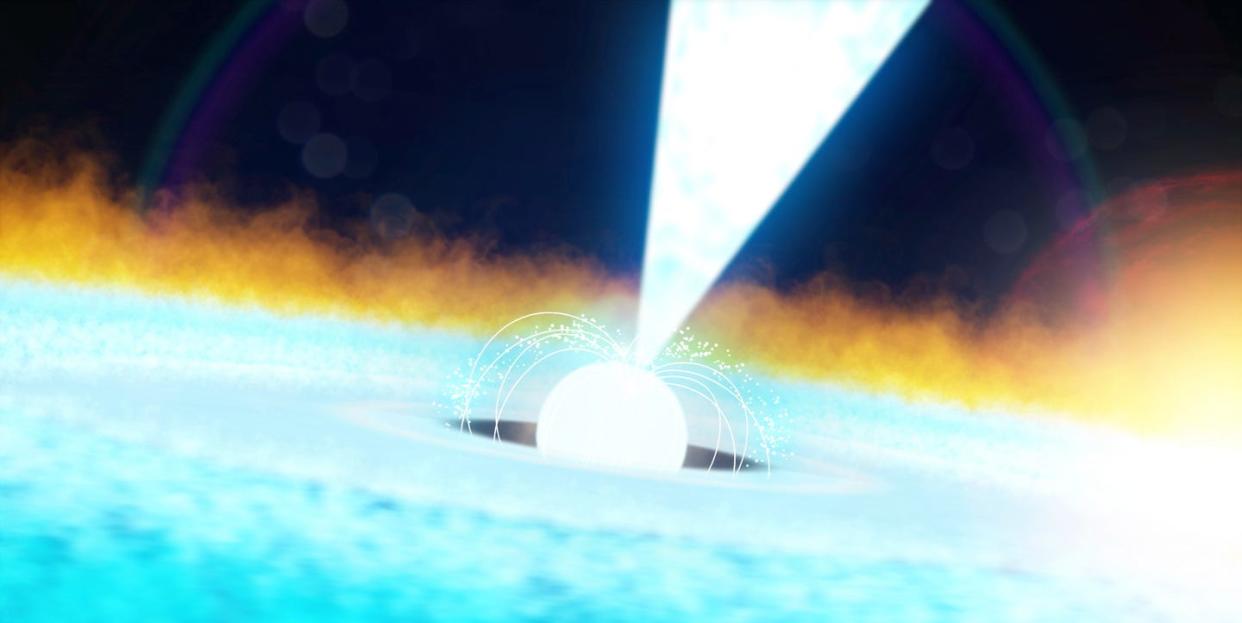NASA Spots Massive, Trippy Thermonuclear Blast

A NASA telescope caught sight of a record-breaking burst of X-rays from a neutron star.
This burst revealed a never-before-seen change in a pulsar’s brightness.
The SAX J1808 neutron star is roughly 11,000 light years away from Earth in the Sagittarius constellation.
A telescope perched aboard the International Space Station (ISS) spotted something very strange back in August: a sudden spike of X-rays surging out of a pulsar 11,000 lightyears away in the Sagittarius constellation. It was the brightest pulse of X-rays NASA has ever witnessed.
This particular explosion, from the pulsar SAX J1808, is called a Type 1 X-ray burst, according to a paper published in The Astrophysical Journal Letters. Pulsars are rapidly spinning and condensed cores left over from the death of a massive neutron star. As pulsars spin, they pulse high-energy radiation out across the universe at a regular interval.
“This burst was outstanding,” said astrophysicist and study author Peter Bult of NASA’s Goddard Space Flight Center and the University of Maryland, College Park. The X-ray burst released as much energy in 20 seconds as the sun does in almost 10 days, according to a statement from NASA. The pulsar spins at a rate of about 401 rotations each second.
SAX J1808 feeds on hydrogen gas drawn from a nearby brown dwarf star and pulls that gas into an accretionary disk. Sometimes that disk becomes too dense, and the gases within it become ionized, trapping energy. Hydrogen gas rains down on the pulsar’s surface and the pressure and temperatures skyrocket, causing nuclear fusion and, eventually, a massive thermonuclear explosion across the pulsar’s surface.
On August 20, the NICER telescope on the @Space_Station detected a sudden spike of X-rays coming from the surface of J1808, a pulsar located 11,000 light-years away. The burst released as much energy in 20 seconds as the Sun does in nearly 10 days. https://t.co/Tc20sXwU1o pic.twitter.com/Bnn5Hx80Ay
— NASA Universe (@NASAUniverse) November 7, 2019
The scientists who studied the signals believe the multiple changes in the pulsar’s brightness happen as it shoots off different layers of its surface. The telescope that captured the signals is called the Neutron Star Interior Composition Explorer (NICER).
At the beginning of the X-ray burst, the brightness of the star plateaued for almost a second before increasing at a slower pace. Scientists believe that in this fraction of a second, the star was able to build up enough energy to blast its hydrogen layer into space. The blast swelled for several more seconds before blowing a layer of helium out into space, which quickly overtook the recently expanded hydrogen layer. These changes in brightness stunned researchers reviewing the data.
Other observations of SAX J1808 haven’t revealed the changes seen in the August X-ray burst. Scientists believe this latest show from the neutron star will reveal insight into the inner workings of pulsars.
You Might Also Like

 Yahoo News
Yahoo News 
